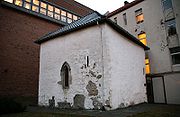
Nonneseter Abbey, Bergen
Encyclopedia

Bergen
Bergen is the second largest city in Norway with a population of as of , . Bergen is the administrative centre of Hordaland county. Greater Bergen or Bergen Metropolitan Area as defined by Statistics Norway, has a population of as of , ....
, Norway
Norway
Norway , officially the Kingdom of Norway, is a Nordic unitary constitutional monarchy whose territory comprises the western portion of the Scandinavian Peninsula, Jan Mayen, and the Arctic archipelago of Svalbard and Bouvet Island. Norway has a total area of and a population of about 4.9 million...
. A small part of the former abbey church remains in use as a chapel, the Nonneseter kapell ("Nonneseter Chapel").
History
Nonneseter Abbey is first recorded by name in 1262, but certainly founded many years earlier, possibly in or about 1150. It was dedicated to the Virgin MaryMary (mother of Jesus)
Mary , commonly referred to as "Saint Mary", "Mother Mary", the "Virgin Mary", the "Blessed Virgin Mary", or "Mary, Mother of God", was a Jewish woman of Nazareth in Galilee...
. The nuns apparently belonged to the Cistercian Order, although this is not confirmed until as late as 1494.
It seems probable that a hospital run by the nuns, documented in 1411, was the forerunner of the later St. George's (Sankt Jørgens) leper
Leprosy
Leprosy or Hansen's disease is a chronic disease caused by the bacteria Mycobacterium leprae and Mycobacterium lepromatosis. Named after physician Gerhard Armauer Hansen, leprosy is primarily a granulomatous disease of the peripheral nerves and mucosa of the upper respiratory tract; skin lesions...
s' hospital.
In 1507 the nuns were ejected for immoral and unseemly behavior and the buildings were transferred to the Hospital Brothers of St. Anthony
Hospital Brothers of St. Anthony
The Hospital Brothers of St. Anthony, Order of St. Anthony or Canons Regular of St. Anthony of Vienne , also Antonines, were a Roman Catholic congregation founded in 1095 or so, with the purpose of caring for those suffering from the common medieval disease of St...
, but the monastery was secularized in 1528, and the premises were converted into a private fortified residence, under the name of Lungegården, by the new proprietor, Vincens Lunge
Vincens Lunge
Vincens Lunge was a Danish noble, member of the Norwegian realm council and the foremost representative of King Christian III of Denmark in Norway.-Biography:...
.
Site and buildings
The abbey was located on a promontory on the north bank of the Lillestrømmen, a stream which once connected two bodies of water, Store LungegårdsvannetStore Lungegårdsvannet
Store Lungegårdsvannet is a bay located in the city and municipality of Bergen, Norway. The bay separates the city centre, located in the borough of Bergenhus, from the southern boroughs of the city, Årstad, Fana and Ytrebygda...
and Lille Lungegårdsvannet
Lille Lungegårdsvannet
Lille Lungegårdsvannet is a small lake in the city centre of Bergen, Norway. The octagon-shaped lake was formerly connected to Store Lungegårdsvannet, but the strait between the two was removed in 1926....
, approximately in the area of the present Kaigaten.
The surviving buildings were mostly destroyed by a fire in 1891, and of the monastic buildings there remains nothing to be seen. Of the abbey church there survived the base of the west tower, and the Nonneseter Chapel, originally the south chapel off the choir, which were acquired in 1891 after the fire by the Society for the Preservation of Ancient Norwegian Monuments.
The single story that is left of the west tower, the Tårnfoten ("tower foot"), is near the present Bergen public library, and measures 8.6 meters square. It was originally clad with dressed stone. In the west wall is a portal with a round arch, and in the east wall another, which would have connected to the body of the church.
It is now used as a memorial chapel to the fallen of World War II
World War II
World War II, or the Second World War , was a global conflict lasting from 1939 to 1945, involving most of the world's nations—including all of the great powers—eventually forming two opposing military alliances: the Allies and the Axis...
.
The Romanesque
Romanesque architecture
Romanesque architecture is an architectural style of Medieval Europe characterised by semi-circular arches. There is no consensus for the beginning date of the Romanesque architecture, with proposals ranging from the 6th to the 10th century. It developed in the 12th century into the Gothic style,...
tower foot is more old-fashioned in style than the body of the main church apparently was, indicating the possibility that it could have belonged to an older structure predating the arrival of the Cistercians with their characteristic building style.
The church lay to the east of the tower. The original building was quite small, but it seems to have been extended eastwards in the later 13th century with a new choir and choir chapels; it had a single aisle. The graveyard was to the north of the church, and the monastic buildings to the south, but there are too few remains of them to establish the exact layout.
The site was archaeologically excavated in 1872 and again in 1892.
Nonneseter Chapel
The Nonneseter Chapel (Nonneseter kapell) at Kaigaten 3 is believed to have been one of the choir chapels. It measures about 8 meters by 7 meters, and contains a vaulted ceiling and GothicGothic architecture
Gothic architecture is a style of architecture that flourished during the high and late medieval period. It evolved from Romanesque architecture and was succeeded by Renaissance architecture....
arched windows. It dates from around 1250, which seems to be when the church was extended. Between 1951 and 1989 it was used as a church for deaf people. It is now used, among other ways, as a concert hall.

